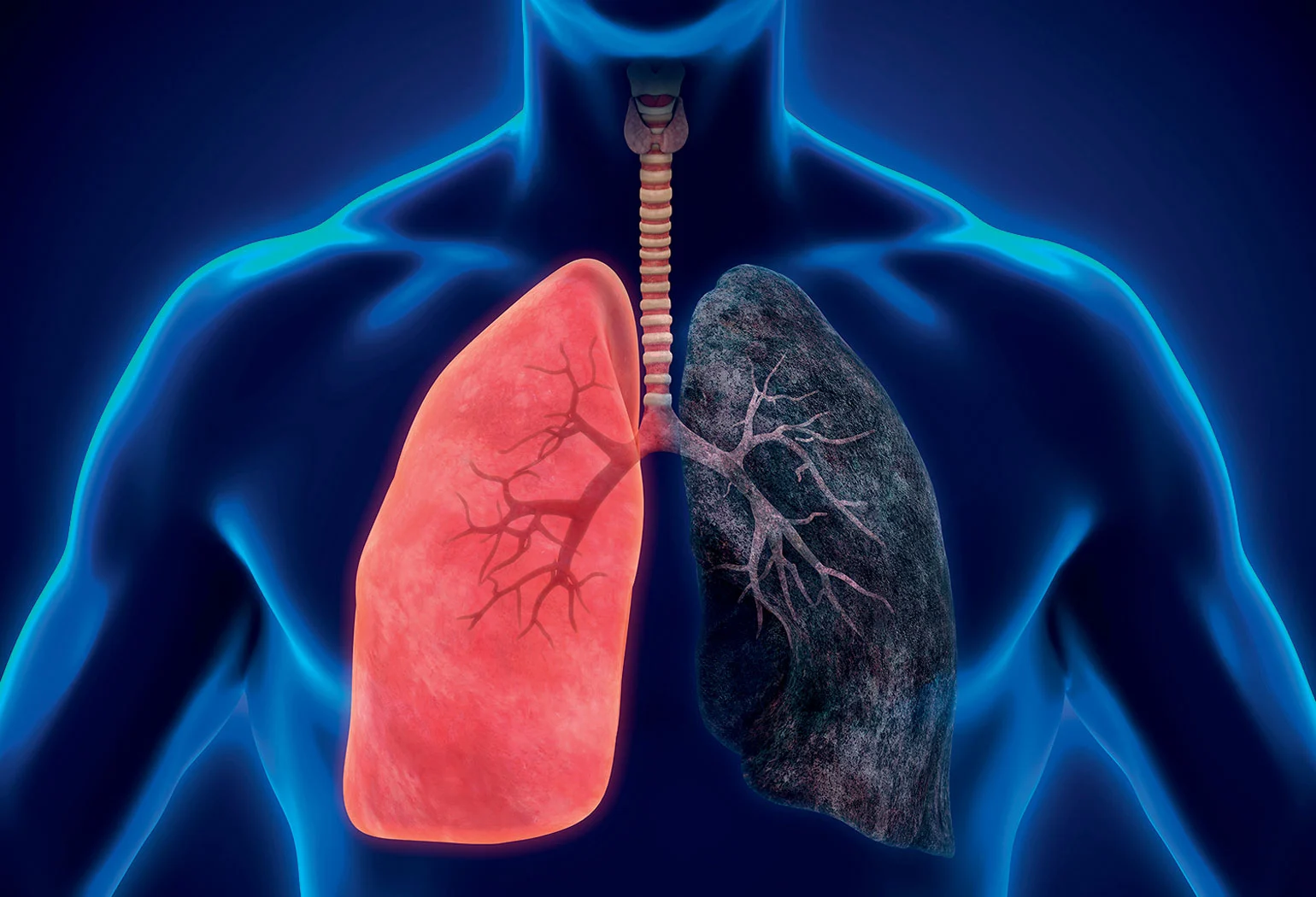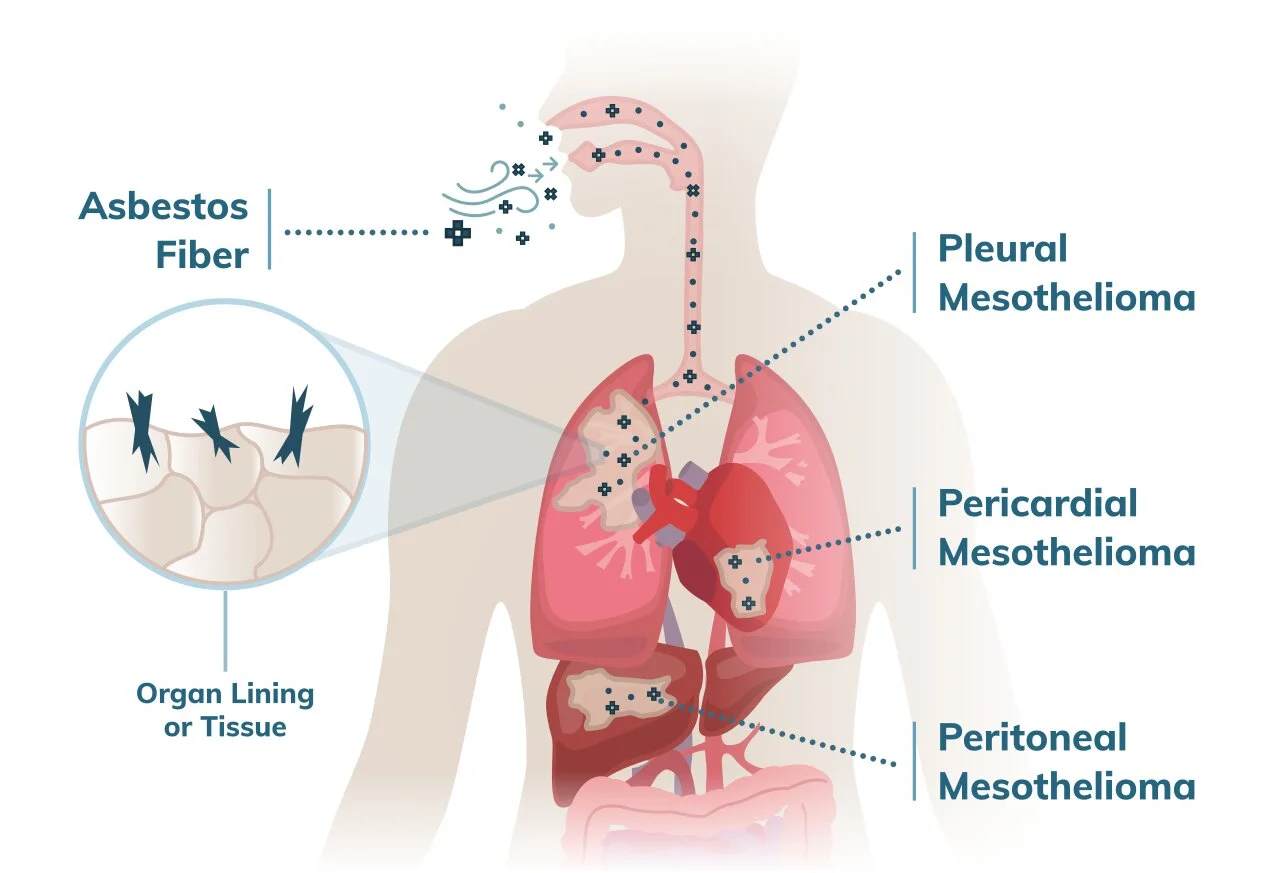Asbestosis is a specific type of pneumoconiosis that is defined as chronic diffuse fibrosis of the lung tissue caused by inhaled asbestos fibers.
Read MoreAsbestosis | Causes, Symptoms, and Treatments
Introduction
Asbestosis is a specific type of pneumoconiosis that is defined as chronic diffuse fibrosis of the lung tissue caused by inhaled asbestos fibers.
It is a chronic disease with a slow onset that usually takes several years of exposure, based on the intensity of the exposure.
Inhaled asbestos fibers stay in the lungs for years and eventually cause severe fibrosis and scarring, which results in lung stiffening that continues long after exposure ceases.
Clinically, it is characterized by diffuse interstitial pulmonary fibrosis, which is frequently accompanied by pleural thickening and sometimes calcification.
Causes of Asbestosis
Asbestos exposure takes three different forms.
Direct work-related environmental exposure is common among workers at shipyards, mining, aerospace, etc.
The second form of exposure is bystander exposure, which is common in certain professionals such as electricians, masons, and painters.
General community exposure, such as the use of asbestos in road surfaces, playground materials, chemical paints, and landfills.
The disease is dose-dependent, and the risk of the disease is higher with the amphibole variety than with serpentine asbestosis fibers.
Occupations at Risk for Asbestosis
- Shipbuilding and repair.
- Production of asbestos cement products.
- Mining and processing of asbestos fibers.
- Insulation workers, and demolition workers.
Currently, work that requires asbestos insulation removal may be the greatest source of exposure.
Signs and Symptoms of Asbestosis
- Shortness of breath on exertion (most common).
- Chest tightness.
- Chest pain.
- Chronic dry cough (cough may be productive, especially among smokers).
- Clubbing of fingers may appear in advanced cases.
- Pleural effusion.
In most cases, crackles, also known as “rales,” are detected near the end of full inspiration and are the first and often only physical sign.
Extent and Severity Grading Scheme for Asbestosis
The grading of severity is as follows: –
Grade 0 → No fibrosis associated with bronchioles.
Grade 1 → Fibrosis involves a wall of at least one respiratory bronchiole, with or without extension into septa of the first adjacent alveolar tiers.
Grade 2 → Same as grade 1, in addition to involvement of the alveolar ducts and two or more tiers of alveoli adjacent to the bronchiole, with some alveoli spared between the bronchioles.
Grade 3 → Same as grade 2, in addition to fibrotic thickening of the septa of all alveoli between at least two adjacent bronchioles.
Grade 4 → Same as grade 3, in addition to the formation of honeycomb changes (formation of cyst-like spaces larger than an alveolus which may be epithelialized).
Grading of the extent of disease is classified according to the percentage of bronchioles showing excessive peribronchiolar fibrosis.
Grade A → Only occasional bronchioles are involved.
Grade B → More than occasional involvement, but less than half.
Grade C → More than half of all bronchioles involved by the fibrosing process.
Diagnosis of Asbestosis
Diagnosis usually requires a history of sufficient exposure to asbestos, established by an accurate occupational history.
The presence of pleural thickening or plaques and asbestos bodies in sputum or bronchoalveolar lavage are indicators for asbestosis.
Sufficient latency (usually 15 or more years), combined with some or all of the following features: –
- “Rales” or crackles.
- Positive chest X-ray or high-resolution CT (most sensitive) findings for fibrosis (which may only appear later in the disease’s progression).
- Reduced lung function (vital capacity, diffusion capacity, total lung capacity, or arterial oxygen tension reduction with exercise).
- Shortness of breath on effort.
Treatment of Asbestosis
There is no cure for asbestosis.
Treatment is typically palliative and may include techniques to increase sputum production and coughing to remove ferruginous bodies from the lungs.
Shortness of breath can be treated with oxygen.
If the individual is also a smoker, he or she must stop and never resume smoking.
Pleural effusion aspiration can also help the patient in breathing more easily.
There are support groups where people can share their common experiences and problems.
Lung Transplantation
When all other treatments have failed to treat chronic and irreversible fibrosis, this is the last treatment for severe asbestosis.
Prevention of Asbestosis
The only way to prevent asbestosis is to stop being exposed to asbestos fibers.
Whenever dealing with any type of asbestos removal or product, personal protective equipment, specifically supplied air respirators, or respirators with HEPA filters should be used.
The use of wet methods will stop asbestos fibers from becoming airborne and thereby reduce exposure.
Summary
Asbestosis is a specific type of pneumoconiosis that is defined as chronic diffuse fibrosis of the lung tissue caused by inhaled asbestos fibers.
It is a chronic disease with a slow onset that usually takes several years of exposure, based on the intensity of the exposure.
Asbestos exposure takes three different forms which include direct work-related environmental exposure, bystander exposure, and general community exposure.
Occupations at risk for asbestosis include the production of asbestos cement products, mining, and processing of asbestos fibers, insulation workers, and demolition workers.
Symptoms of asbestosis include shortness of breath on exertion, chest tightness, chest pain, chronic dry cough, clubbing fingers, and pleural effusion.
Diagnosis usually requires a history of sufficient exposure to asbestos, established by an accurate occupational history.
There is no cure for asbestosis.
Treatment is typically palliative and may include techniques to increase sputum production and coughing to remove ferruginous bodies from the lungs.
The only way to prevent asbestosis is to stop being exposed to asbestos fibers.
Whenever dealing with any type of asbestos removal or product, personal protective equipment, specifically supplied air respirators, or respirators with HEPA filters should be used.
How useful was this post?
Click on a star to rate it!
Average rating 0 / 5. Vote count: 0
No votes so far! Be the first to rate this post.
I'm sorry that this post was not useful for you!
Let me improve this post!
Tell me how I can improve this post?
References
- Harbison, R. D., Bourgeois, M. M., & Johnson, G. T. (2015). Hamilton & Hardy’s industrial toxicology. John Wiley & Sons Inc.
- Asbestosis | researchgate.net. (n.d.). Retrieved December 29, 2022, from ResearchGate
- Asbestosis – researchgate. (n.d.). Retrieved December 29, 2022, from ResearchGate
- Asbestosis – statpearls – NCBI bookshelf. (n.d.). Retrieved December 29, 2022, from PubMed
- Guidotti, T. L. (2011). Global Occupational Health. Oxford University Press.
Hazard pictograms warn us when a potentially harmful chemical is nearby. The pictograms inform us that the chemicals we use may be harmful to people or the environment. This article...
Read MoreOccupational health is the science of promoting health and reducing illness as a result of an individual's job relationship. The science of protecting workers' health by controlling the work environment.
Read MoreMesothelioma is a rare and deadly cancer that originates from mesothelial cells of the pleura or serosal surfaces such as the peritoneum, pericardium, and tunica vaginalis.
Read MoreRecent Posts
-
SAPHO Syndrome | Causes, Symptoms, Diagnosis & Treatments
-
Systemic Lupus Erythematosus | Causes, Symptoms & Treatments
-
Gastric Ulcers | Causes, Symptoms, Complications & Treatments
-
Wiskott-Aldrich Syndrome | Causes, Symptoms & Treatments
-
The 4 Stages of HIV Infection | Ultimate Guide
-
Good’s Syndrome | Symptoms, Causes & Treatments
-
Acquired Angioedema | Causes, Symptoms & Treatments
-
Rheumatoid Arthritis | Symptoms, Causes, Diagnosis & Treatments
-
Acute Pancreatitis | Causes, Symptoms, Diagnosis and Treatments
-
Pernicious Anemia | Causes, Symptoms, Diagnosis and Treatments
-
Sickle Cell Anemia | Causes, Symptoms, Diagnosis and Treatments
-
Aplastic Anemia | Causes, Symptoms, Diagnosis and Treatments
-
Diamond Blackfan Anemia | Causes, Diagnosis and Treatments
-
Sideroblastic Anemia | Causes, Symptoms & Treatments
-
Organic Dust Toxic Syndrome (ODTS) | Symptoms, and Treatments





